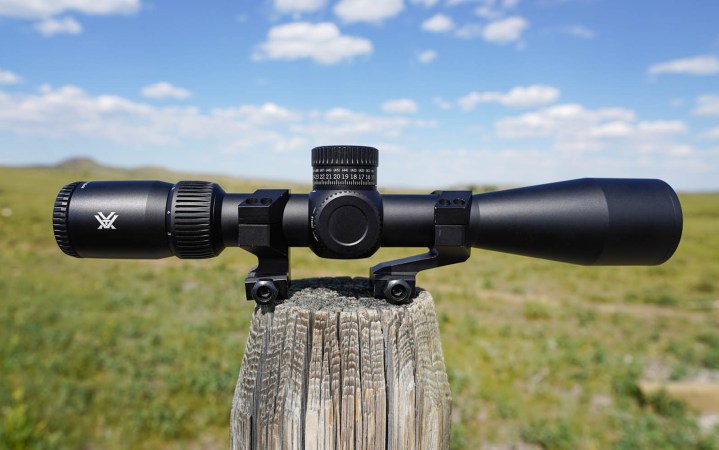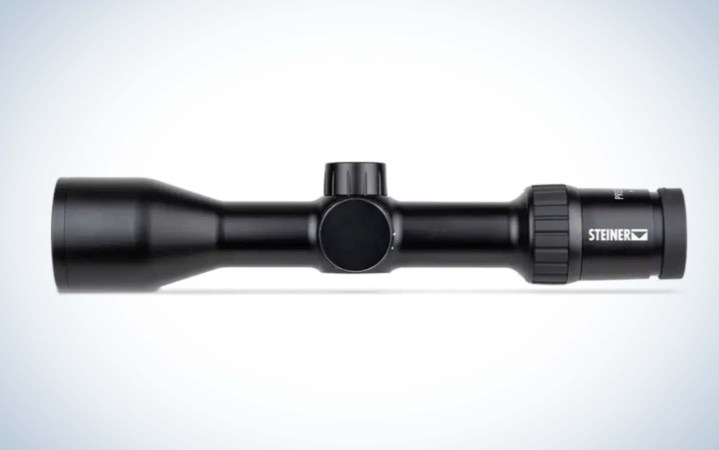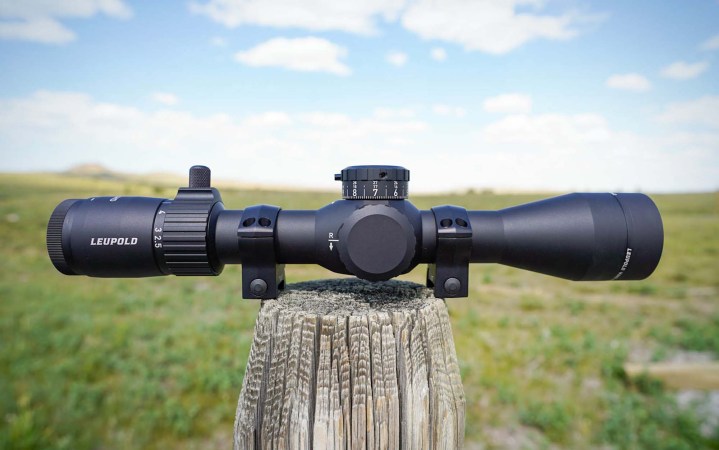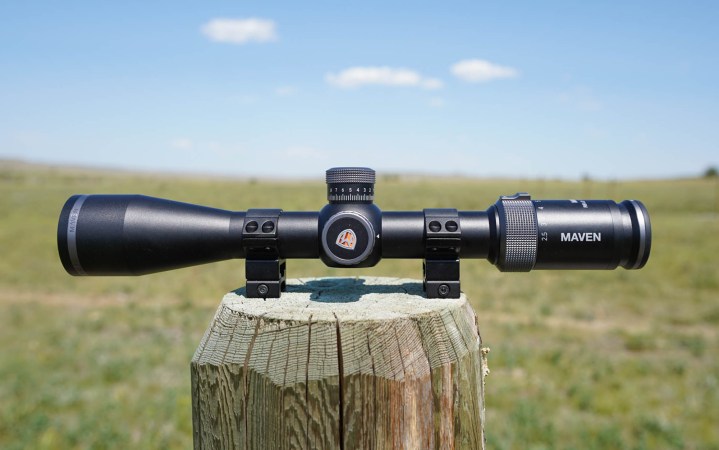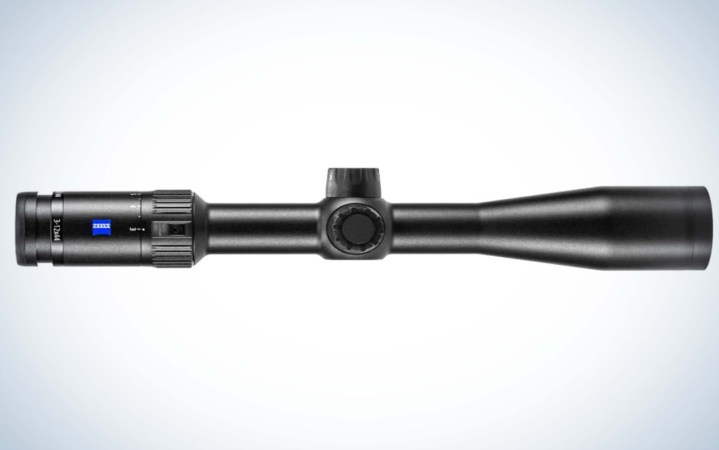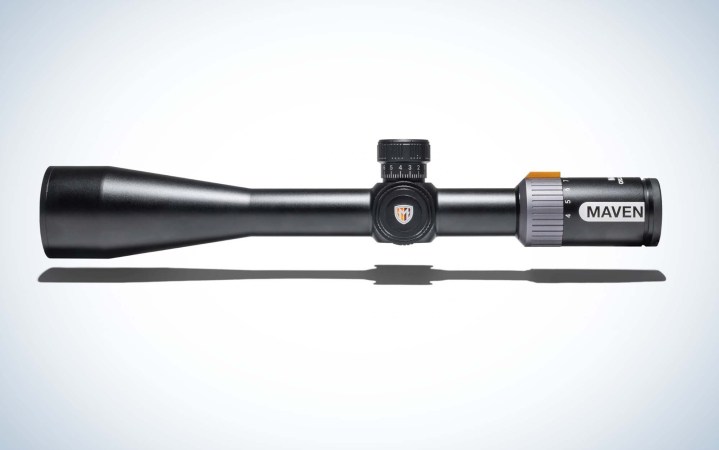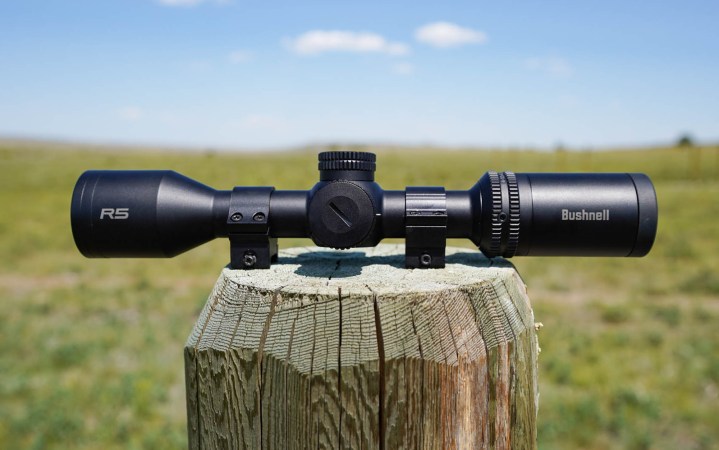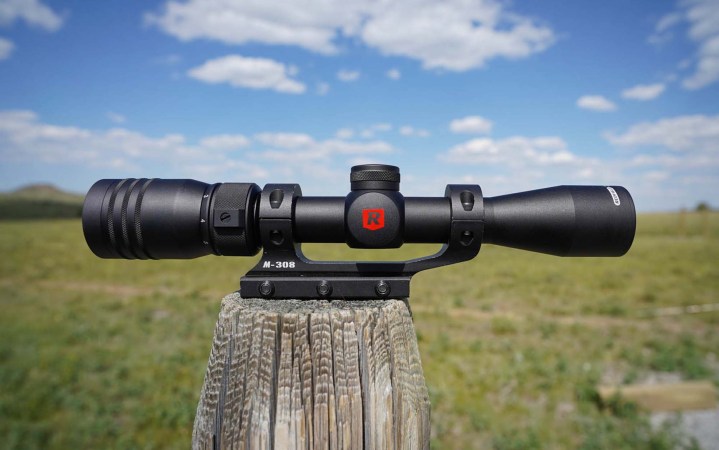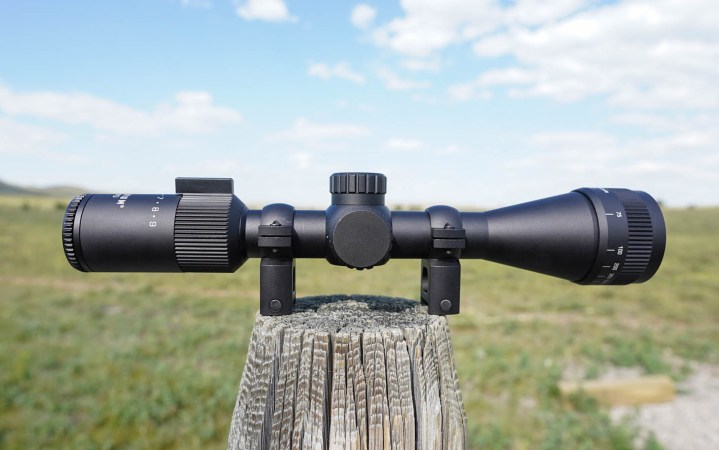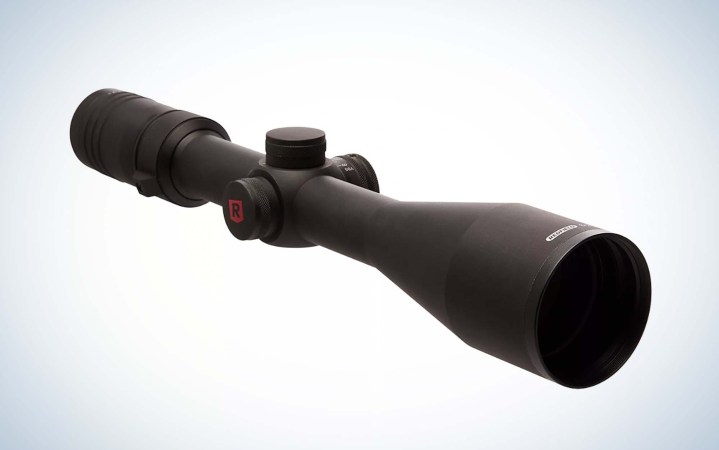We might earn income from the merchandise out there on this web page and take part in affiliate applications. Study Extra ›
Are you on the lookout for a light-weight scope to your mountain rifle? Listed here are 4 or 5 new fashions to select from. Perhaps you desire a scope with a first-plane reticle and uncovered turrets so you’ll be able to both maintain or dial your intention as vital. There’s a half-dozen of those long-rangers in our check. Or possibly you’re on the lookout for a scope for a child’s first rifle and have solely $200 to spend. There’s a handful of selections right here.
The gathering of mid-power rifle scopes — I name them versatile scopes due to their extensive utility — which might be primarily configured for searching is so giant and messy this 12 months that we figured we’d break the 18 submissions into value ranges. It’s unfair, in any case, to check a $99 Redfield to a $2,100 Steiner. Worth isn’t the proper approach to divide the category, however it’s how many people store for optics, and usually permits us to check scopes of comparable abilities towards one another.
On the prime of sophistication are premium scopes that value over $1,000, and in some instances over $2,000. You’ll see a number of the normal manufacturers right here —Steiner, Burris, Leupold, Maven. And on the backside of the roster are price range scopes — six of them priced underneath $250 — that may be characterised both as appalling junk or distinctive values, relying on the unit. And within the center are treasured few ranging in value from $500 to $1,000, a market I want the trade would higher serve.
↓ Leap to Premium Searching Scopes
↓ Leap to Mid-Worth Searching Scopes
↓ Leap to Funds Searching Scopes
How We Examined the Greatest Searching Scopes

As a result of rifle scopes are basically aiming units, we consider them on a special foundation than binoculars or recognizing scopes, optical devices which have broader utility. We’re within the precision of a rifle scope, so our scoring standards provides extra weight to attributes that obtain that objective.
We check optical efficiency, similar as we do spotters and binoculars. However we spend extra time on 4 standards that we expect are the beating coronary heart of a strong rifle scope. Our inside aiming system issues are reticle fashion and utility, illumination, reticle references, and visibility. Our exterior aiming system analysis considers turret positivity and indexing, the scope’s zero cease, parallax management, and complete adjustment vary, or how far shooters can stretch the turrets’ elevation and windage clicks. We additionally check a spread of attributes that we bundle underneath the heading precision, which incorporates turret monitoring, return to zero, the trueness of the scope’s magnification, parallax, and subject of view. After which we ask testers to fee a scope’s shootability, which considers eye reduction, eyebox, the benefit of use at numerous magnifications, and the scope’s versatility.
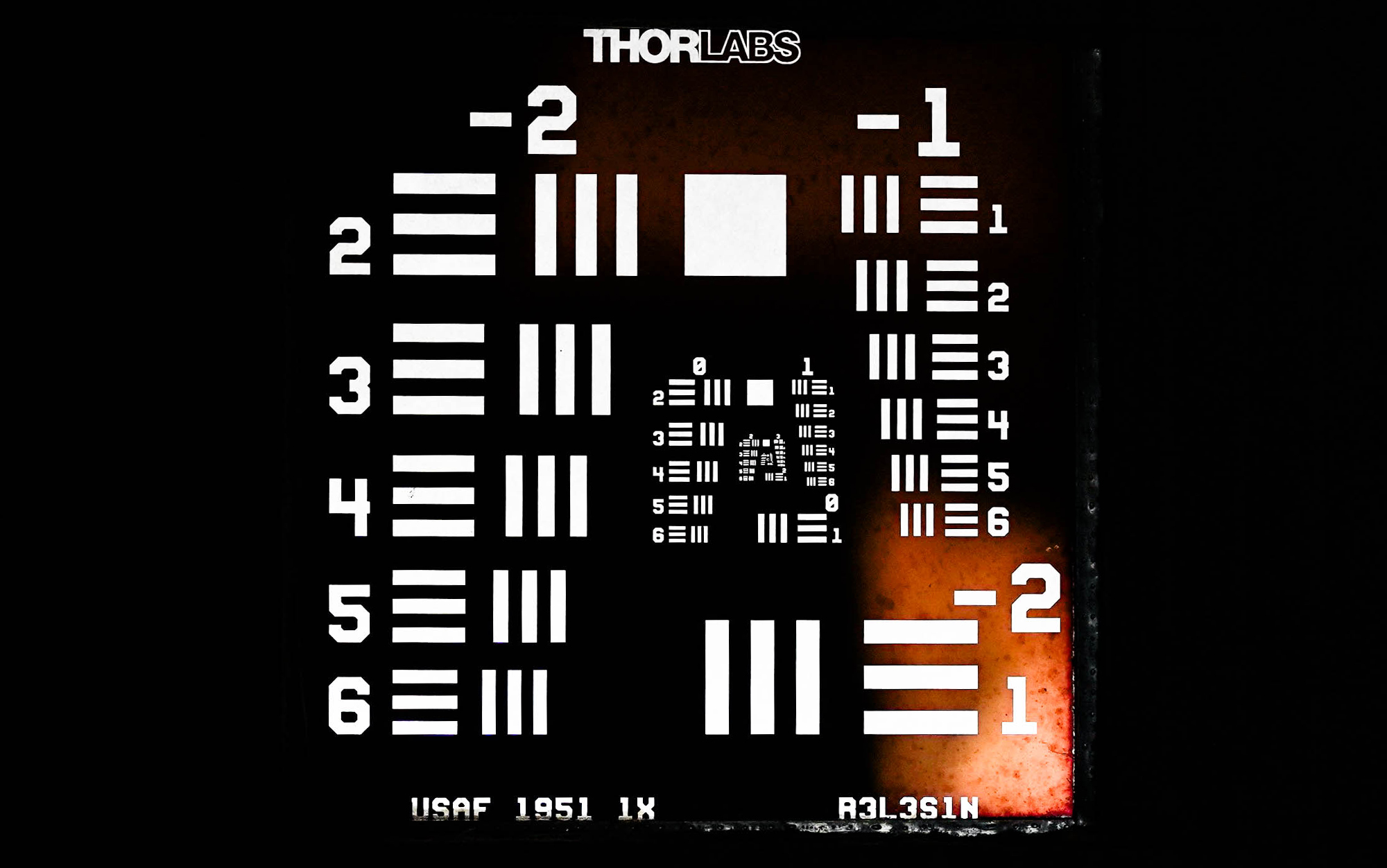
That final consideration — versatility — might be probably the most significant on this class. We’re curious about scopes that may span a variety of makes use of, from ringing metal at a mile to killing a twitchy mule deer at 1 / 4 that distance. Goal-shooting attributes are a plus, however so is portability, a clear however helpful reticle, exact and constructive turret clicks, illumination, and clear glass. We additionally reward scopes that may do triple responsibility as close-in rimfire goal optics, mountain searching companions, and long-range competitors scopes.
We put all submissions by the identical standards. First, we measure optical decision, utilizing the diminishing black-and-white traces of a 1951 Air Drive Decision Goal to attain the optical efficiency of every submission. We additionally measure the low-light efficiency of every “versatile” scope by mounting them to tripods and focusing them as a gaggle at 200 yards at a black-and-white decision goal at twilight, all with a purpose to measure the brightness and sharpness of the glass and visibility of the unilluminated reticle.
We break our 10-point scoring into 4 normal classes: optical efficiency (25 p.c of complete grade), aiming system (50 p.c of complete grade), design (15 p.c), and worth (10 p.c). The common of those classes is the idea of our grades, detailed beneath.
Optical efficiency contains the decision and low-light assessments plus the extra subjective assessments of picture high quality and brightness. Aiming-system efficiency assesses inside and exterior aiming system, precision, and that squishy shootability evaluation. Design considers the outside end, inside blacking, mounting dimensions, and sturdiness.
After which our value/worth rating charges how a lot scope — together with guarantee and facilities comparable to rings, further turrets, and lens covers — you get to your cash. The rifle scope that will get the very best total rating wins our editor’s selection award for the very best within the class; the optic with the very best value/worth rating wins our nice purchase recognition, and we give different awards primarily based on particular attributes.
How We Grade Searching Scopes
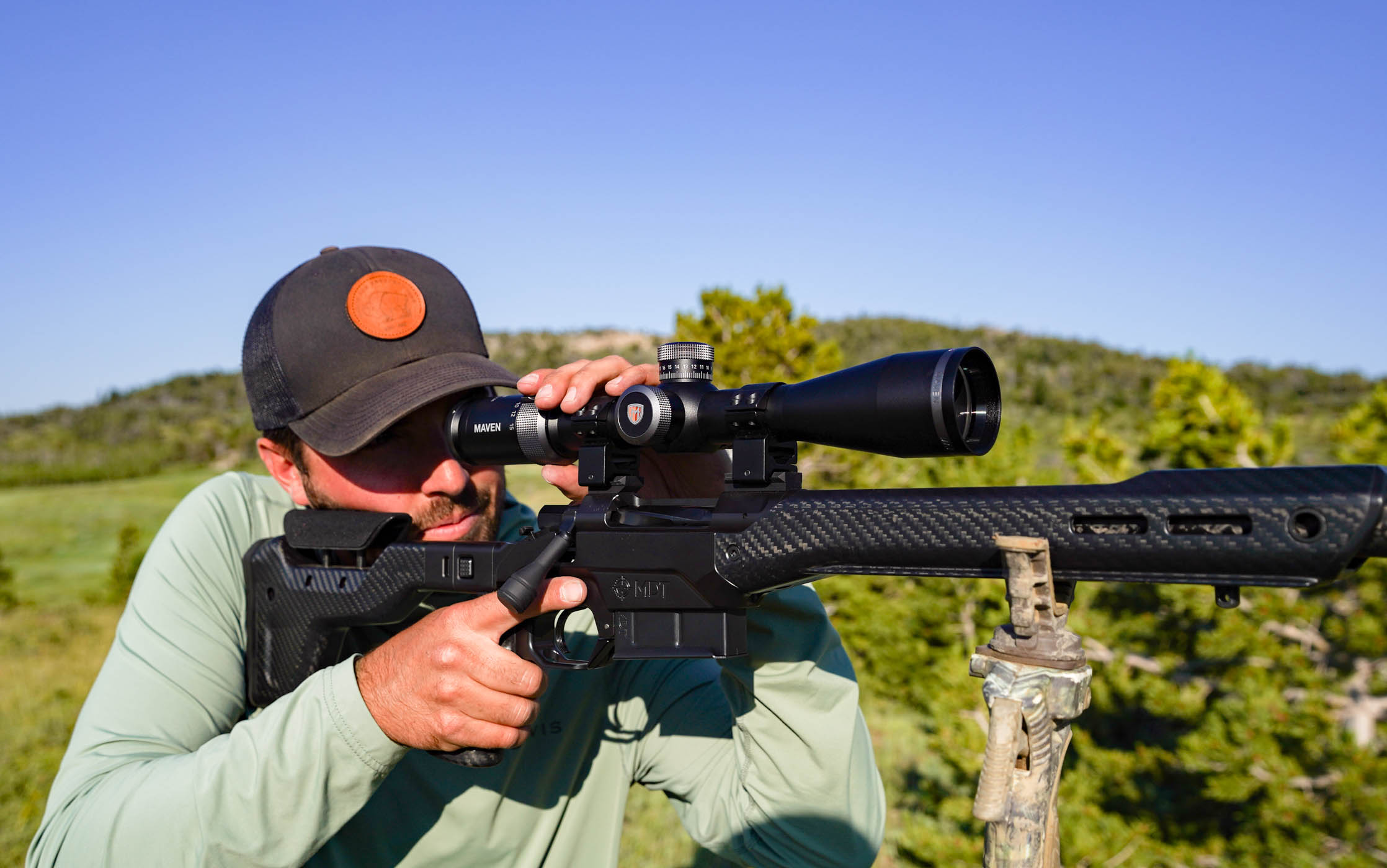
Our 100-point analysis provides as much as a complete numeric rating, however we translate these to grades for every submission. Our optical efficiency grade combines the scores from decision, low-light, and picture high quality. Our aiming system efficiency grade aggregates the inside/exterior aiming system, precision, and shootability scores. The design grade considers building, innovation, versatility, and sturdiness. After which the worth/worth grade is our worth grade.
To earn a wonderful grade, the common of that class have to be 9 or greater, which is extraordinarily onerous to realize. Superb is a mean rating of seven to 9. An excellent grade is 5 to 7. Our honest grade is 3 to five, and poor is something underneath 3.
Greatest Premium Searching Scopes: Critiques & Suggestions
Editor’s Alternative: Vortex Viper HD 3-15×44
Rating Card
- Optical Efficiency: Superb
- Mechanical Efficiency: Wonderful
- Design: Superb
- Worth/Worth: Superb
Key Options
- 30mm tube
- Second-plane VMR-3 MOA-based reticle
- Pull-to-turn uncovered elevation turret, capped windage turret
- Turrets tuned to .25 MOA clicks
- 102 MOA elevation adjustment (47 MOA with RevStop put in)
- 20 yards to infinity facet parallax management
- Push-button center-dot illumination
- Worth: $1,000
Execs
- 5x magnification vary
- Versatile hash-based reticle out there in MOA or MIL references
- At 11.8 inches and 23 ounces, a really gentle and compact scope
- Customized turrets out there from Vortex
- Ships with sunshade and neoprene cowl
- Optionally available zero cease is good contact
Cons
- Comparatively vague turret clicks
- Turret indexing is complicated
- Illuminated dot flares noticeably
With this center-of-mass scope, Vortex has constructed an all-arounder that may thrive on any Western hunt, however which may serve capably on a rimfire precision rifle, nearly any deer rifle, and even ring distant metal in a pinch. That’s the very definition of versatility.
That is really a tough steadiness to strike. Being the opinionated bunch we’re, shooters will sniff at an MOA-based scope, however then complain that the MRAD competitor doesn’t have a second-plane reticle. Or a shooter may desire a 3-18-power zoom vary however prefers an uncovered elevation turret. Or they demand a zero cease and a second-plane reticle however will completely reject capped turrets. It’s sufficient to drive a scope designer loopy.
Vortex launched its new Viper HD line of scopes to the market this summer time, with fashions within the 2-10×42, 3-15×44, and 5-25×50 configurations. The center sibling displays the very best steadiness of portability, versatility, and attributes and wins our editor’s selection as the very best versatile scope of the 12 months.
Optically, these are superb scopes. Whereas there’s nothing particularly wow-worthy concerning the glass, there’s nothing that may distract from the scope’s job, and we detected no main flaring, edge distortion, or different aberrations. The Viper HD posted prime scores in each our decision and low-light testing.

The reticle is an excellent steadiness of pace and precision. Whereas our check scope was delivered in MOA, the Viper HD can be out there in an MRAD model, additional confirming its versatility. The second-plane reticle is split in 2 MOA (.5 MRAD) hashes, with 30 MOA (9 MRAD) elevation references and 18 MOA (5 MRAD) windage references on both facet of the middle cross.
When you get aware of the references, the scope delivers a pleasant steadiness of pace and precision. We additionally just like the superb (.13 MOA/.04 MRAD) heart dot, which is illuminated with a purple gentle, activated by a push-button module and adjustable from a barely seen aiming level for low-light circumstances or blazingly brilliant for daylight taking pictures.
Different clutch options embrace a 20-yards-to-infinity parallax management, which makes this a sensible choice for a precision rimfire rig. Vortex’s glorious RevStop zero cease might be eliminated or added as wanted. The RevStop does considerably restrict the elevation adjustment, decreasing it from a powerful 102 MOA (30.5 MRAD) right down to 47 MOA (18.9 MRAD). However for turret dialers who desire a rock-solid cease, the RevStop is straightforward and efficient. And for individuals who need to dial to the horizon, merely take away the RevStop and maintain turning.
After all, we discovered some shortcomings. The turret indexing could be very busy, with squintingly superb references for 2 full revolutions. The turret gearing appears a bit of plasticky, delivering clicks which might be a mushy and vague. And the center-point illumination just isn’t coherent, that means that it flares and bleeds into the reticle, particularly at full depth.
On the upside, we acquired an early model of customized turrets that Vortex has added as a free premium for the 3-15×44 Viper HD. Ours was tuned to the 40-grain .22 CCI bullets we shot, and labored completely, giving our testers an additional selection about whether or not to dial to distance or use reticle references to carry.
We favored the mounting dimensions of the Vortex, and the 44mm goal lens is sized about proper for low-profile mounting on a wide range of rifle sorts. At about $850 real-world avenue value, we understand this can be a expensive scope, however it’s proper in the course of the sphere, and given all the flexibility it delivers, we expect it’s an excellent worth on a wonderful all-around searching scope.
Learn our full assessment of the Vortex Viper HD line for more information.
Greatest Over $1,000: Steiner Predator 4 4-16×44
Rating Card
- Optical Efficiency: Superb
- Mechanical Efficiency: Wonderful
- Design: Wonderful
- Worth/Worth: Superb
Key Options
- 30mm tube
- Second-plane E3 ballistic reticle
- Low-profile capped turrets tuned to .25 MOA clicks
- Re-zeroable turrets
- 20 yards to infinity facet parallax management
- 11-step purple center-cross illumination
Execs
- At 18 ounces and 10.9 inches, very compact and lightweight
- Reticle optimized for searching circumstances
- Easy and constructive controls
- Wonderful glass
- Sized to be used with clip-on thermals
Cons
- Pretty restricted mounting dimensions
- Turrets are onerous to show
As most versatile rifle scopes develop in weight and size, with a purpose to accommodate all of the bells (illumination and facet parallax) and whistles (uncovered tactical turrets, big magnification ranges) of the class, it’s refreshing to see a scope shrink in dimension however enhance in efficiency.
That’s the take-away from this marvelous little workhorse from Steiner. The lightest 4-16x scope available on the market, the Predator 4 is 25 p.c shorter than its opponents whereas nonetheless delivering a helpful magnification vary and loads of reticle adjustment. With capped controls and a good construct, this can be a pure searching scope that’s supposed to be carried.

The guts of the Steiner is a well-known second-plane reticle, the E3 ballistic reticle that we’ve seen in Burris scopes. Is sensible, since Steiner and Burris are siblings, owned by the identical Beretta Group. The reticle has three easy and clear elevation hashes with distance-informed windage dots. Zero your rifle at 100 yards, and the primary hash represents a 200-yard maintain, the second a 300-yard maintain, and the bottom hash a 400-yard maintain. The windage references conform to five and 10 mph right-angle wind values.
The low-profile turrets are re-zeroable, and whereas their small diameter makes them onerous to show, they’re tight and unobtrusive. We’d prefer to see a bit extra texturing on the very easy however mannerly controls.
Testers indulged fantasies about which rifle they’d pair with the Predator 4. Some thought its size is suited to an AR sample, others a walk-about deer rifle. I’m already pondering of the ultralight mountain rifle I need to construct across the Steiner. Like its large brother, Steiner’s H6Xi, additionally within the check, the Predator 4’s brief size is meant to pair with a clip-on thermal sight, furthering its versatility.
At about $1,200, this can be a expensive scope, particularly when you think about its per-ounce value. However for a pure searching scope that’s at dwelling in all kinds of rifles and in a spread of situations, it’s one of many gems of this 12 months’s subject.
Greatest Versatile Digital Scope: Burris Veracity PH 2.5-12×42
Rating Card
- Optical Efficiency: Superb
- Mechanical Efficiency: Superb
- Design: Superb
- Worth/Worth: Good
Key Options
- 30mm tube
- First-plane 3PW Wind MOA reticle
- Digital heads-up show signifies elevation maintain
- Clickless programmable elevation turret tuned to .25 MOA clicks
- Re-zeroable turrets
- 25 yards to infinity facet parallax management
- Pink center-cross illumination
Execs
- Extraordinarily programmable and customizable
- Pairs with BurrisConnect cell app
- Clickless elevation turret permits for superb tuning maintain
- Wonderful glass
- Helpful even when battery dies
Cons
- Comparatively tedious set-up
- Glass brought about eye fatigue in some testers
- Operate dial is straightforward to confuse with parallax knob
We struggled a bit with the primary iteration of the Veracity PH, which was in final 12 months’s check. The interface with the cell app was glitchy, and the inputs didn’t appear to information bullets exactly previous about 300 yards. With this second era of the sensible scope Burris has simplified the interface, and we discovered it to be responsive, exact, and actually enjoyable to shoot as soon as we had all of the inputs in place.

Photograph by Scott Einsmann
Like many ballistics solvers, you get out of the Veracity PH what you place in, that means that you should have exact muzzle velocity, ballistic coefficient, and different inputs loaded into the Burris app with a purpose to get the scope to information a bullet’s parabola correctly. However if you do, taking pictures exactly is a matter of porting the custom-made ballistics into the rifle, ranging your goal, dialing the elevation knob to the suitable yardage, holding the place it tells you to, studying the wind, and delivering the bullet. We shot the Veracity PH on a variety of rifles, together with a 6.5 PRC chassis rifle, a 6.8 Western bolt gun, and an entire rack of .22 precision rifles, and located the system labored nicely throughout platforms.

The digital brains of the Veracity PH are the headliners of the scope, to the diploma that it’s straightforward to neglect its extra pedestrian options. However the Burris has good glass, although it’s a bit of undercoated for our liking. The aggressively textured controls flip with precision. The reticle, with 12 MOA of windage holds on both facet of the illuminated heart cross, is beneficial, and we just like the tapered posts for centering our eye on the goal.
The primary design flaw we famous is that the 2 left-side controls — the within knob for parallax and the skin management for powering up the heads-up show, connecting to Bluetooth, and controlling illumination — are straightforward to combine up whereas a shooter is behind the scope. Whereas making an attempt to focus our goal, we’d usually flip off the unit, requiring a pause in taking pictures whereas we reconnected to the app.
However that’s one of many only a few demerits we gave the Burris. At a bit of over $1,300, it’s expensive, however completely consistent with its plentiful attributes.
The general dealing with of the scope is sweet sufficient that the check group had a vigorous debate about whether or not the Veracity PH ought to win the class as probably the most versatile scope on this 12 months’s subject. Finally, its few demerits saved it from the highest spot, however its extensive utility, elevated user-friendliness, and bullet-placing abilities make the Veracity PH probably the most versatile scopes we’ve ever examined.
Greatest for Pairing with a Thermal Clip On: Steiner H6Xi 2-12×42
Rating Card
- Optical Efficiency: Superb
- Mechanical Efficiency: Wonderful
- Design: Superb
- Worth/Worth: good
Key Options
- 30mm tube
- First-plane MHR (Fashionable Hunter Reticle)
- Low-profile uncovered elevation turret, capped windage turret
- Turrets tuned to .25 MOA clicks
- 70 MOA windage/elevation adjustment vary
- 25 yards to infinity facet parallax management
- 11-step purple center-cross illumination
Execs
- 6x magnification vary
- Versatile searching reticle with elevation and wind holds
- At 11.8 inches and 23 ounces, a really gentle and compact scope
- Wonderful turret indexing
- Ships with premium lens caps and throw levers
Cons
- Turret, parallax, and illumination knurling is finger-shredding sharp
- At $2,183, probably the most costly scopes in our check
- Reticle references not seen till about 6x
Welcome to a brand new configuration of European rifle scope. This Steiner packs a 6x zoom vary, first-plane reticle, glorious illumination, and best-in-class glass in a package deal lower than 12 inches lengthy. Its compact construct is designed to operate as a daylight scope, however then settle for a clip-on thermal machine for evening searching. The brief size allows shooters to simply attain the clip-on controls whereas staying within the scope’s eye field.
We didn’t check the scope’s functionality as a clip-on slave, however the Steiner, which is engineered, machined, and assembled in Greeley, Colorado, in operations shared by Burris, wowed us with all-around dealing with and glorious glass.
“It’s one of many uncommon scopes that I may see on an AR and on a customized sheep rifle,” stated tester Todd Netto, who added that it handles like an LPVO however “has far more attain and usefulness.”
The glass is first-rate and begins to justify its over-$2,000 price ticket. Little touches like a locking diopter, optionally available capped elevation turret, and two totally different types of throw lever add to its dealing with. The Steiner’s compactness is a large attribute, and whereas we complained concerning the aggressive knurling of the H6Xi’s turret, parallax, and illumination controls — “shark-tooth turrets may legit minimize somebody,” says tester Luke Coccoli — we favored the positivity of the controls.
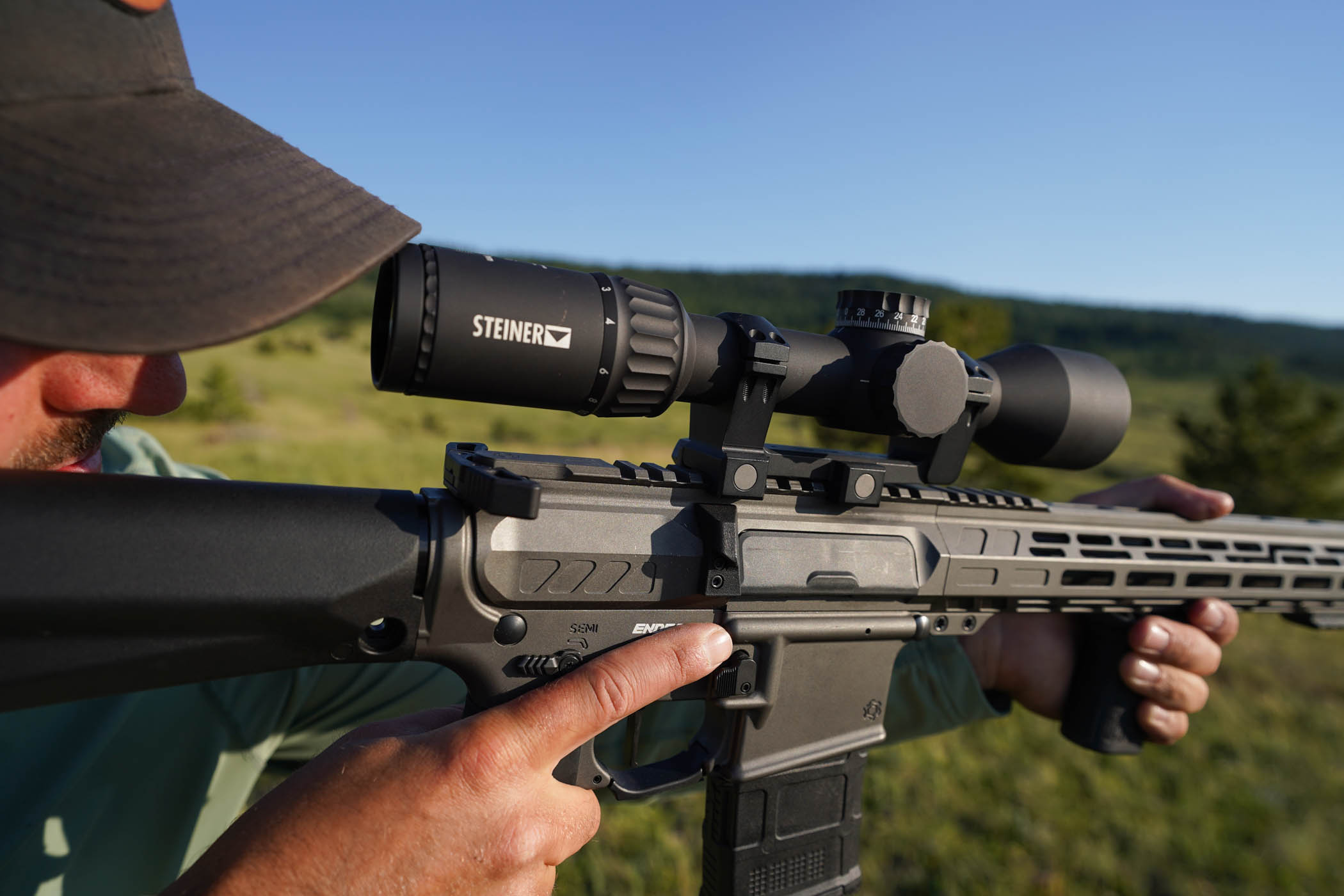
Photograph by Scott Einsmann
What we didn’t like is a reasonably large deal. At first look, the MHR (Fashionable Searching Reticle) is each helpful and acquainted, trying lots like Burris’s glorious E3 reticle. For these of us who need just some references in a searching reticle, it’s a really interesting design. Nevertheless it’s additionally a wierd mash-up of references and adjustability, particularly in its first-plane association.
The .5 MOA heart cross permits for exact aiming, and the windage references, with 2 MOA on both facet of the middle, are helpful. However the holdover references are a wierd mixture of MOA and bullet-drop that get wider the decrease they’re on the vertical stadia, as you’d anticipate of a BDC (Bullet Drop Compensator). Mixed with the uncovered elevation turret (although, as we talked about, there’s an optionally available cap), the configuration confuses relatively than simplifies a searching state of affairs.
References of the first-plane reticle aren’t seen till about 6x, and even at full 12x magnification, the references are onerous to see, even with the purple illumination absolutely blazing.
We’d prefer to say that every one the opposite glorious attributes of the Steiner compensate for an underwhelming reticle, however on condition that the reticle is the center of the optic, we needed to take away the H6Xi from our editor’s selection choice as the very best versatile scope of the 12 months. Nevertheless it stays a best choice, particularly for hunters who desire a great daylight scope that may simply transition to the evening.
Greatest Tactical Searching: Leupold Mark 4HD 2.5-10×42
Rating Card
- Optical Efficiency: Superb
- Mechanical Efficiency: Wonderful
- Design: Good
- Worth/Worth: Good
Key Options
- 30mm tube
- Obtainable in second-plane or first-plane TMR (Tactical Milling Reticle)
- Uncovered elevation turret with Zero Lock
- Capped windage turret
- Turrets tuned to .1 MRAD clicks
- 85 MOA (24.7 MIL) elevation adjustment vary
- Fastened 150-yard parallax
- Eight-step center-reticle illumination
Execs
- 4x magnification vary
- Versatile searching reticle with elevation and wind holds
- At 12.5 inches and 21 ounces, a really gentle and compact scope
- Wonderful turret indexing
- Easy and exact controls
- Push-button illumination has auto-shutoff
Cons
- With out handbook parallax setting, some focus points
- Reticle illumination may very well be brighter
The current pattern in all-around rifle scopes is to push the upper finish of their capabilities, including to searching scopes’ attributes for precision goal work. So it’s refreshing to see versatility on the different finish of the efficiency spectrum, with short- to medium-range goal work mixed with small-game to deer searching chops.
This nimble new scope from Leupold, one of many configurations within the new Mark 4HD line, capably bridges use-cases from AR carbine work to 3-gun competitions to searching in nearly each place deer dwell. The Mark 4HD line makes use of the identical glorious glass and coatings from the pricier Mark 5HD line, however in a trimmer construct and at a extra accessible value.
The two.5-10x scope is so versatile, it’s onerous to pin down particularly the place it’s at its finest. Is it a chosen marksman scope for mid-distance precision work on an AR platform? Is it as a enjoyable competitors scope? Is it a mountain-hunting optic atop a customized sheep rifle?

Photograph by Scott Einsmann
Reality is, this helpful little scope within the new Mark 4HD line is the entire above. We named it the very best tactical searching scope as a testomony to its potential to crossover. Our check pattern got here with a second-plane reticle, however the versatility is additional boosted by the first-plane model of the two.5-10×42 due to the extra precision work that reticle allows.
Nonetheless, our second-plane pattern was no slouch, although we did have minor monitoring points. The Zero Lock elevation turret is large, straightforward to function, and the indexing is a number of the finest within the subject. The push-button illumination is quick, sensible, and stylish, and the throw lever on the outsized zoom dial allows fast magnification adjustments.
The reticle, with half-MIL steps, affords 4 MILs of holdover and windage, and has the additional advantage, uncommon on this class, of ranging traces on the ends of the illuminated stadia. Within the second-plane configuration, the scope must be on 10x with a purpose to subtend accurately, however that modest magnification is ideal for many taking pictures and searching functions when exact sub-tension is required.
Testers thought the scope was overpriced in comparison with its friends, however the Mark 4HD affords a ton of utility in a troublesome, nimble package deal.
Greatest Western Searching Scope: Maven RS1.2 2.5-15×44
Rating Card
- Optical Efficiency: Superb
- Mechanical Efficiency: Wonderful
- Design: Wonderful
- Worth/Worth: Superb
Key Options
- 30mm tube
- First-plane MOA-2 reticle (additionally out there in SHR-MIL and SHR-W MOA)
- Uncovered re-zeroable elevation turret, capped re-zeroable windage turret
- Turrets tuned to .25 MOA clicks
- 100 MOA (29 MIL) elevation adjustment vary
- 5.6 yards to infinity facet parallax management
- 11-step purple center-dot illumination
Execs
- 6x magnification vary
- Brass zero cease
- Instrument-less turret elimination
- Wonderful indexing all through
- Premium extra-low-dispersion glass
Cons
- Reticle too busy for some searching conditions
- Illumination too faint
- Reticle references not seen till about 5x
With this brilliant, powerful, and beautiful scope, Maven has given long-range hunters all the things they may need. You’re a holdover hunter? The primary-plane reticle has helpful elevation and windage references. Oh, you’d relatively dial your aiming resolution? The uncovered elevation dial turns with exact positivity and affords an astonishing 100 MOA of elevation journey. You like MIL-based reticles? The RS1.2 has Maven’s SHR reticle in MIL subtensions. Otherwise you’re an MOA shooter? The scope comes within the simplified SHR-W MOA-based reticle, or the busier MOA-2 of our check pattern.
With so many choices, Maven has doubled down on its worth proposition to Western hunters. It is a scope that may attain means on the market for a distant pronghorn or elk, and doubles as a serviceable steel-target rig.
The glass is great; it completed close to the highest of our low-light check, beating a number of 50mm scopes. The controls are easy and exact. Whereas we typically choose capped turrets on a searching scope, Maven’s tool-less uncovered turret is each elegant and practical, and gives straightforward in-the-field entry to re-zero the turret and set its glorious zero cease.
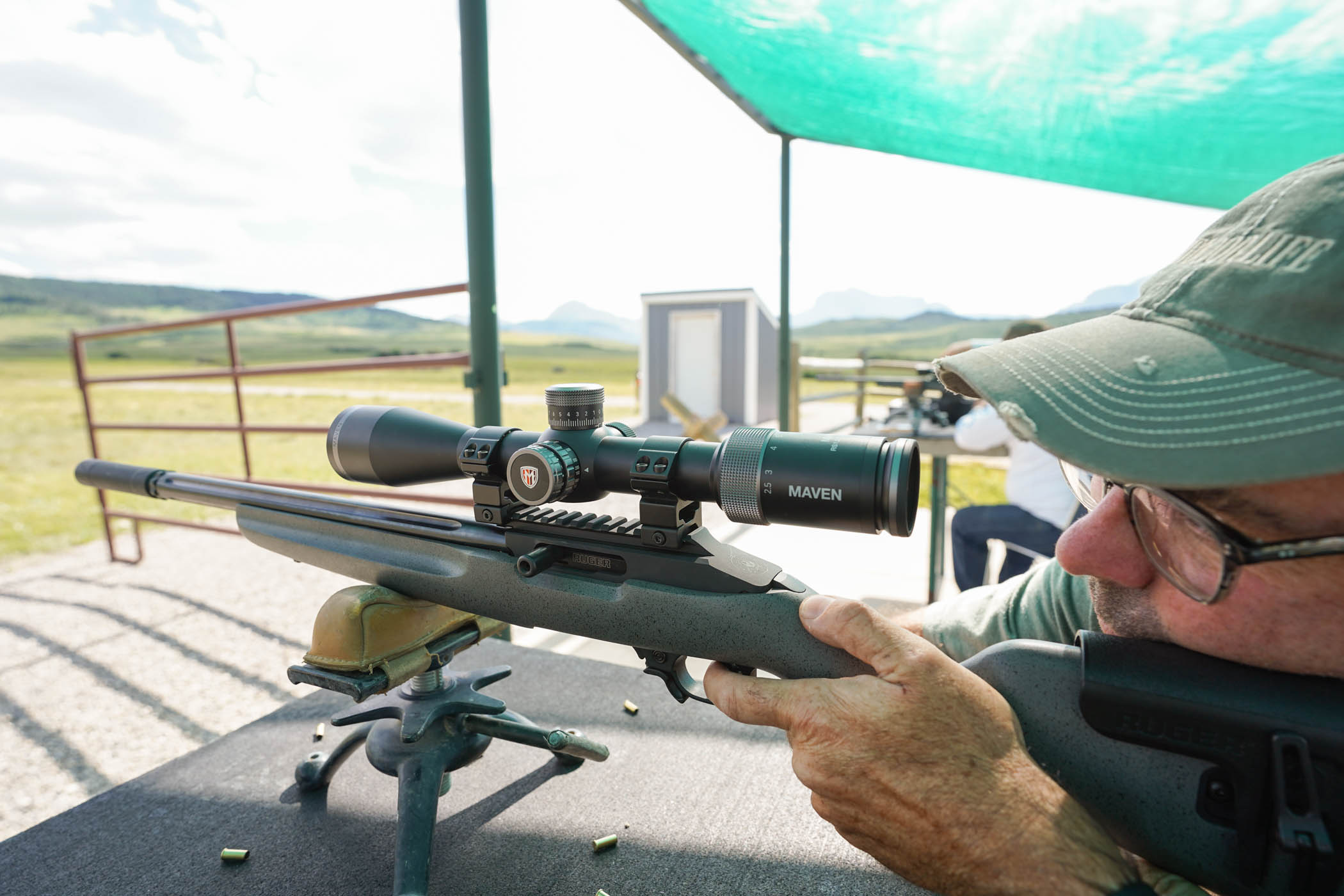
Photograph by Scott Einsmann
Among the many parts that didn’t fairly dwell as much as our expectations, the center-dot illumination is exact and in the appropriate gentle makes a really good aiming level. However the illumination doesn’t assist a lot in daylight circumstances. At 26.4 ounces, this can be a hefty optic, which makes it lower than supreme for light-weight searching rifles. On the different finish of the spectrum, although, its excessive shut focus and superb reticle makes it an awesome precision rimfire rig.
At $1,200, the RS1.2 is a dear scope, however contemplating its dizzying quantity and high quality of facilities, the check group felt it was pretty priced.
Customers must resolve for themselves if Maven’s more-is-more method is for them. Half our check group liked the sheer versatility this scope affords; the opposite half felt there’s simply an excessive amount of happening, to the diploma that it would distract from the kind of quick, instinctive taking pictures that always defines, and in the end ends, a Western hunt.
Greatest Mid-Worth Searching Scopes: Critiques & Suggestions
Greatest General: Zeiss Conquest V4 3-12×44
Rating Card
- Optical Efficiency: Wonderful
- Mechanical Efficiency: Superb
- Design: Superb
- Worth/Worth: Good
Key Options
- 30mm tube
- Second-plane Zeiss #20 Z-Plex duplex reticle
- Uncovered elevation turret tuned to .25 MOA clicks
- 70 MOA inner adjustment vary
- Capped re-zeroable windage turret
- Additionally out there in 3-12×56 model
Execs
- Brass ballistic cease
- Helpful 4x zoom vary
- Premium glass and coatings
- Extraordinarily light-weight at 18.2 ounces
Cons
- Parallax fastened at 100 yards
- Duplex reticles limits precision work
For these of us who for years have appreciated the sincere worth of Zeiss’s Conquest scopes, there’s a brand new object of our affection. Zeiss has launched a brand new configuration of the V4, in a lightweight, easy, and brilliant 3-12×44 that’s constructed for hunters who desire a quick, uncluttered scope however who intend to dial longish photographs.
The brand new Conquest V4 doesn’t have an unbiased parallax knob — parallax is fastened at 100 yards — and neither does it have illumination. It has a easy Z-Plex reticle with no elevation or windage holds. The scope’s lone adjustment, in addition to its velvety power-changing ring, is an uncovered elevation turret that turns with positivity.
The concept is {that a} hunter, within the second of engagement, doesn’t have to be distracted by selections. Do I maintain on reticle references? Or do I dial to distance? Do I focus my goal? What magnification do my reticle subtensions require? All these choice — and indecision — factors are launched into the second by scopes which have the distracting variety of facilities that manufacturers suppose hunters need. With its V4, Zeiss is betting {that a} sure hunter needs much less, no more.
The three-12-power scope is suited to any variety of searching conditions, and its extraordinarily gentle 18.2-ounce heft makes it a sensible choice for a mountain rifle. Provided that its elevation turret is designed to be dialed, Zeiss has added its strong brass Ballistic Cease, giving shooters a really helpful return-to-zero characteristic. Turret indexing is daring and clear, additional enhancing its dial-ability. Testers had combined opinions of the uncovered turret; some wished the elevation turret capped to keep away from inadvertent turning within the subject. Others felt it’s finest uncapped to facilitate quick dialing. The Ballistic Cease is a vital characteristic in order that customers can simply verify their zero on the uncovered turret.
The glass and coatings are glorious, controls transfer easily and certainly, and the dearth of superfluous knobs provides the Zeiss a streamlined, elegant fashion. At just below $850, the Japan-sourced Conquest is an efficient worth in a really serviceable searching scope.
Greatest for Whitetails: Vortex Viper HD 2-10×42
Rating Card
- Optical Efficiency: Superb
- Mechanical Efficiency: Superb
- Design: Good
- Worth/Worth: Good
Key Options
- 30mm tube
- Second-plane Lifeless-Maintain BDC
- Capped turrets tuned to .25 MOA
- 135 MOA complete elevation adjustment
- 100-yard fastened parallax
- Pink center-dot illumination
Execs
- Easy, set-it-and-forget-it operation
- Reticle has helpful bullet-drop references
- Sensible push-button illumination
- Simply re-zeroable turrets
- Compact: 12.1 inches lengthy and 19.9 ounces
Cons
- Might use a throw lever
- Reticle isn’t fitted to precision work
With only a few uncovered controls and a bombproof construct, this little Vortex can be at dwelling on a mountain rifle, or a backcountry horseback hunt that requires shucking your gun out and in of a saddle scabbard. Nevertheless it’s additionally simply concerning the excellent mid-distance whitetail scope, with a quick and precise-enough reticle, and a very good illumination for each daylight and last-light visibility.
The guts of the scope is Vortex’s glorious Lifeless-Maintain BDC reticle with a .13-MOA heart dot and three elevation hashes that begin 1.5 MOA beneath the crosshair after which are spaced 3 MOA aside. The ballistician in me notes that they don’t actually conform to the parabola of a bullet, which drops geometrically, not arithmetically. However customers can tune the drops to their particular load utilizing Vortex’s Lengthy Vary Ballistics Calculator, which helps broaden the utility of the reticle. The reticle has 8 MOA of windage holds, at 2 MOA areas, on both facet of the crosshair.
The capped turrets are easy and helpful, in step with the reticle, and the elevation turret allows an astonishing 135 MOA of journey. The spring-loaded turret dial is straightforward to re-zero within the subject, although we’d prefer to see extra seen turret indexing.
Whereas the Viper HD doesn’t have an exterior parallax management — parallax is fastened at 100 yards — we solely struggled with goal acquisition inside 25 yards, main some testers to notice this isn’t an excellent rimfire scope. Past about 600 yards we once more struggled with focus, as goal edges didn’t appear particularly sharp. However within the center distances, the picture is evident and brilliant, and reticle visibility is great.
Visibility is additional enhanced with Vortex’s superb push-button illumination that lights up the middle dot. We subtracted factors for the dot’s vital flaring, particularly at excessive intensities.
Testers have been combined on the worth. At about $600 real-world avenue value, half the group thought it was priced proper for its extensive capabilities. The opposite half thought it was overpriced, contemplating all of the facilities it doesn’t have. That reveals you that, much more than ergonomics and design, value/worth is a subjective evaluation.
The use instances for this scope are infinite. It’s a good AR carbine scope. It might be at dwelling on an expedition rifle. However we reckoned that, given its versatility, its easy operation, and its mid-range abilities, that it’s the very best whitetail scope in our check, with loads of abilities for work nicely past deer nation.
Greatest Beanfield Scope: Maven CRS.3 4-20×50
Rating Card
- Optical Efficiency: Superb
- Mechanical Efficiency: Superb
- Design: Good
- Worth/Worth: Superb
Key Options
- 30mm tube
- First-plane SHR-MIL reticle
- Uncovered turrets tuned to .1 MRAD
- 25 MIL (75 MOA) complete elevation adjustment
- 10 yards to infinity parallax
- Pink center-dot illumination
Execs
- At $800, a reasonably accessible long-range searching rig
- Good glass and coatings
- Illumination has off settings between depth steps
- Instrument-less re-zeroable turrets
- Obtainable in MOA or MIL variations
Cons
- Controls are too tight
- Uncovered turrets not supreme for searching
With this very large (27-ounce, 15.4-inch) scope, Maven is filling out its CRS line of scopes. You may recall the corporate’s first scope within the household, a really light-weight and minimalist 3-12×40 that also sells for $375, an awesome deal. This 4-20×50 apparently serves the Western hunter who additionally needs to ring metal. Within the outdated days, we might have known as this a beanfield scope, and I feel the time period nonetheless suits, because it’s a bit of large for a walk-about optic however has some selection options for long-range searching and goal work.
The guts of the CRS.3 is Maven’s very succesful SHR (Simplified Holdover Reticle), which has simply sufficient holdover and hold-off references with out being too cluttered. Our MIL model has an open aiming level with floating heart dot, after which .5 MIL steps down the vertical stadia, right down to 10 MILs of holdover, with distance-adjusted windage references.
That’s about all you should make distance-informed photographs means on the market. The uncovered turrets are very stiff however transfer with satisfyingly audible and tactile clicks. Each turrets have threaded caps that may be eliminated within the subject to rezero the dials.
The middle-point illumination is a pleasant contact, although we want it blazed daylight-bright at its greater intensities. And the facet parallax, although it too turns onerous, gives good goal readability from 10 yards to infinity.
To date, so good. These are all the identical attributes, by the way, as might be discovered on the opposite Maven in our versatile scope check, the RS1.2. So why this iteration? The 50mm goal is a greater low-light rig, and the highest magnification (20x) provides shooters a finer view of the goal. The CRS.3 can be $400 cheaper than the RS1, although it additionally carries a barely much less premium grade of glass, and the ponderously heavy scope limits its extensive utility.
Like most Maven optics, it’s a good, sturdy, and intensely shootable scope, however in contrast to the sooner model of the CRS household, it doesn’t appear to have the flexibility or the worth/worth attraction of its siblings.
Eotech Vudu X
Rating Card
- Optical Efficiency: Superb
- Mechanical Efficiency: Superb
- Design: Good
- Worth/Worth: Good
Key Options
- 30mm tube
- Second-plane BD1 (Ballistic Drop 1) reticle
- Capped turrets tuned to .25 MOA
- 80 MOA complete elevation adjustment
- 25 yard to infinity facet parallax
- Pink center-cross illumination
Execs
- Easy and sturdy operation
- Reticle has helpful bullet-drop references
- Simply re-zeroable turrets
- Helpful throw lever
Cons
- Spinoff design
- Illumination may very well be brighter
- Turret clicks are mushy
In the event you suppose you’re seeing a ghost, you’re not all improper. This a brand-new model of Eotech’s venerable Vudu line, however sourced within the Philippines, relatively than Japan, with some acquainted and a few new attributes. A few of these attributes might remind shooters of one other ghost: Nikon’s now-defunct line of rifle scopes.
The primary by-product element of the X model of the Vudu is the round holdover references on the second-plane reticle’s elevation stadia. They reminded testers of Nikon’s Spot On reticle, with related round references that allow quick, precise-enough aiming. The Vudu X has 4 circles, they usually’re spaced at 2, 4, 6, and eight MOA beneath the crosshair, for straightforward referencing.
The capped turrets are tuned to .25 MOA, making reticle/turret settlement straightforward and clear. The turrets are re-zeroable, however customers have to thoroughly take away the dials with a purpose to reset them. That, and the mushy clicks, are disappointing given the opposite tight attributes of the scope. We like the graceful and agency power-changing dial and the aggressive throw lever. The 25-yard parallax is a pleasant contact, giving this in any other case mid-range scope some close-in functionality.
The Vudu X’s glass was disappointing, given the gem-bright glass of the unique Vudu. However the brand new iteration is about half the worth of the Japan-sourced scope. Testers nonetheless thought that, at about $850, the Vudu X is overpriced, however beneficial it for all the things from all-around big-game searching to restricted tactical work.
Riton 5 Primal 2-12×44
Rating Card
- Optical Efficiency: Good
- Mechanical Efficiency: Superb
- Design: Good
- Worth/Worth: Poor
Key Options
- 30mm tube
- Second-plane RDH duplex reticle
- Capped low-profile turrets tuned to .25 MOA
- 90 MOA complete elevation adjustment
- 15 yard to infinity facet parallax
- Pink center-dot illumination
Execs
- 6x magnification zoom
- Exact illuminated aiming level
- Very quick reticle deployment
- Tactile, grippy turret dials
- Three-height throw lever
Cons
- Odd configuration
- At over $700, expensive
- Underwhelming glass
That is an oddball. On the one hand, the duplex reticle allows very quick both-eyes-open taking pictures, a functionality that’s additional enhanced with a brilliant pinpoint center-dot aiming dot. However, that’s an attribute higher suited to an LPVO, not a full-size 1.5-pound scope.
The turrets are large, meaty, and enjoyable to show. However they’re additionally capped, which limits their utility for in-the-moment dialing. Then there’s the glass, which scored nicely on our decision vary however close to the underside of low-light efficiency. Testers famous peripheral fuzziness and a few shade fringing.
However I’m a agency believer that for each scope there’s an ideal use, and the Riton can be an exquisite mid-range bullseye optic. The illuminated heart dot, which seems to be about .25 MOA, facilities the attention, and the facet parallax sharpens the goal. The heavy scope settles properly on both benches or luggage. The three-position throw lever makes magnification adjustments fluid and quick. And, with a 15-yard shut focus, it will make an awesome 50-meter rimfire rig.
That stated, the 5 Primal is offered with a hash-style reticle with intensive elevation and windage references round a floating .5 MOA heart dot. That’s most likely the higher choice for shooters and hunters who need to take the Riton off the bench and into the sphere.
Greatest Funds Searching Scopes: Critiques & Suggestions
Greatest Worth: Bushnell R5 4-12×40
Rating Card
- Optical Efficiency: Good
- Mechanical Efficiency: Superb
- Design: Good
- Worth/Worth: Good
Key Options
- 30mm tube
- Second-plane DOA-LRH800 illuminated reticle
- Capped, re-zeroable turrets tuned to .25 MOA clicks
- 60 MOA windage/elevation adjustment vary
- 10 yards to infinity facet parallax management
- 6-step purple center-dot illumination
Execs
- 4x magnification vary
- Versatile searching reticle with elevation and wind holds
- Wonderful illumination with off settings between depth steps
- Reticle references knowledgeable by Bushnell Ballistic App
Cons
- Poor turret/reticle monitoring
- Turrets tighten noticeably as they backside out
Bushnell has packed a ton of options into its new R5 line. The 4-12×40 in our check has an excellent center-dot purple LED illumination, and the facet parallax focuses targets as shut as 10 yards, making this an excellent air gun or rimfire scope. The second-plane reticle has first rate references out to 800 yards. And the brief (11.5-inch) scope properly suits AR-pattern rifles or youth weapons.
The accessible value (MSRP is $239 however you’ll be able to most likely discover this for underneath $200) makes it a sensible selection for all kinds of searching and taking pictures platforms, particularly for price range gunners.
However there’s a price to all these facilities in a price range scope, and customers can pay it in creaky controls. We observed that the zoom dial turns simply at decrease magnifications, however then tightens towards greater powers. Identical with the turrets; they flip simply and sharply in the course of their adjustment vary, however as they close to the upper and decrease ends of their journey, they begin to stick. That’s an indication of low cost erector parts, and we fear that customers who actually power the turrets may find yourself breaking them.
The Bushnell’s glass was higher than we anticipated; it posted an excellent decision rating and the 40mm scope did okay in low-light evaluations.
The DOA reticle is first rate, providing MOA-based holds out to 800 yards and windage holds in each 5 and 10 mph right-angle winds. However the references are very superb, and a few testers famous that they disappear towards cluttered backgrounds.
Nonetheless, for a hunter who needs a scope with a lot of transferring components and facilities, the R5 is priced proper, and Bushnell’s lifetime guarantee is an efficient backstop in case any of these transferring components cease transferring. Given its plentiful searching chops for a particularly reasonable value, we awarded the R5 with our nice purchase award for the hunting-scope class.
Greatest Entry-Degree: Bushnell R3 3-9×40
Rating Card
- Optical Efficiency: Honest
- Mechanical Efficiency: Good
- Design: Honest
- Worth/Worth: Superb
Key Options
- 1-inch tube
- Second-plane DOA-QBR reticle
- Capped re-zeroable turrets tuned to .25 MOA clicks
- 65 MOA windage/elevation adjustment vary
- Reticle references out to 600 yards
Execs
- 3x magnification vary
- At about $120, an excellent worth
- Bullet drop holds knowledgeable by Bushnell ballistic app
Cons
- Fastened parallax causes some focus points
- No illumination
- Spongy turret tactility
With its new R3 household of optics, Bushnell has a brand new entry-level scope that provides some very interesting attributes for a starting hunter or a shooter on a price range.
First is its value. For a bit of over $100 you get an sincere scope with sufficient reticle references to make knowledgeable photographs at center distances. The glass is murky however it’s ok for 90 p.c of a hunter’s time within the subject. The re-zeroable turrets are mushy however serviceable. In brief, it’s a strong effort.
We’ve been followers of Bushnell’s DOA reticle because it got here on the scene within the model’s Trophy line of scopes almost 20 years in the past, and the mix of bullet-drop references and easy windage marks makes it a quick, easy, and efficient searching reticle. With a 100-yard zero, shooters have 4 1 MOA dots for elevation holds, and the highest of the prolonged duplex publish gives a 600-yard reference. It’s not overly exact, however at the very least the references are knowledgeable by ballistic parabolas. Customers can additional fine-tune their bullet velocities to the reticle by pairing it with the free Bushnell Ballistic App.
We fear concerning the sturdiness of this scope, although it was one of many few price range scopes that didn’t fog after a freeze-thaw check. Moreover, the Bushnell’s fastened parallax limits its utility at each very brief and really lengthy distances. However these are comparatively minor quibbles for a scope that will be at dwelling on a primary squirrel gun or deer rifle.
Greatest Entry-Degree Rimfire Scope: Redfield Insurgent 2-7×32
Rating Card
- Optical Efficiency: Poor
- Mechanical Efficiency: Honest
- Design: Honest
- Worth/Worth: Good
Key Options
- 1-inch tube
- Second-plane non-illuminated duplex reticle
- Re-zeroable capped turrets tuned to .25 MOA clicks
- 30 MOA inner windage and elevation adjustment
- 50-yard fastened parallax
- 12.6 ounces
Execs
- Few uncovered controls
- At underneath $100, an accessible value
- Respectable rimfire scope
Cons
- Poor building
- Slender utility
My delight at having Redfield again in our optics check pale as its rifle scopes underwhelmed on our analysis vary. No scope failed any job, however of the three in our subject, none notably wowed us or reminded us of this model’s grand heritage.
Redfield is without doubt one of the former greats of the American optics trade, going afield with at the very least two generations of sportsmen. However then the rise of superb Japanese optics, extra inexpensive on the time than the American-made glass, took market share, and European manufacturers made a profitable bid for American hunters. Venerable home manufacturers like Redfield, Weaver, and Bausch + Lomb pale into the background. Leupold made a brief play for Redfield, which is now the home optics model for Academy Sports activities.
The two-7×32 Redfield is probably the most area of interest of the trio. There’s not lots to this scope, however at a $99 retail value, it’s not supposed as a utility participant. As an alternative, it’s supposed as a primary scope for a child’s .22, or possibly a light-recoiling deer rifle. With that use-case in thoughts, the Insurgent is ample, however it’s not going far past its low expectations.
The duplex reticle is clear and customary, and the turrets, tuned to .25 MOA clicks, really moved with extra authority and tactility than we anticipated. An much more stunning attribute is that the turrets are simply re-zeroed.
However the Redfield’s glass is fairly cringy, and on condition that our pattern fogged up after a freeze-thaw check, we fear concerning the total sturdiness of the construct. However should you deal with it nicely, it ought to get just a few years of use earlier than consumers graduate out of the entry-level market into their subsequent scope, which given its renaissance may nicely be a Redfield.
Greatest Cut price: Monstrum Guardian 3-9×40
Rating Card
- Optical Efficiency: Honest
- Mechanical Efficiency: Honest
- Design: Honest
- Worth/Worth: Good
Key Options
- 1-inch tube
- Second-plane “MOA-Dot” reticle
- Pink and inexperienced full-reticle illumination
- Capped turrets tuned to .25 MOA clicks
- Goal-bell parallax management, 25 yards to infinity
Execs
- Plenty of attributes for a price-point scope
- Re-zeroable turrets
- Helpful throw lever
- At $50, a screaming discount
- Ships with shoot-through rings and flip-up lens caps
Cons
- Poor turret indexing
- Some lens fogging
- Squinty glass
How on earth can a producer carry to market a serviceable rifle scope for $50? And embrace a set of rings with the optic? That’s the query we’ve been asking for a few years, as we’ve seen the model Monstrum promoting boatloads of scopes by Amazon’s on-line retail retailer. So we invited Monstrum to our check, partly to show to ourselves that their low cost optics aren’t really a discount.
So shade us stunned to seek out that their 3-9×40 Guardian isn’t that unhealthy. Okay, it flunked the low-light check and testers reported complications and squints after a session behind the scope, however on issues that matter for a rifle scope, the Monstrum fared decently. Its turrets tracked completely with its reticle and its illumination fired up the reticle in each greens and reds. Its objective-bell parallax is clunky, however targeted targets from about 35 yards to means on the market.
There are some vital sturdiness points with this scope. Its inner lenses fogged after a freeze-thaw check, and we observed an unsettling vibration within the erector system, like the thrill of a mouth harp, if we tapped the scope. The reticle, which Monstrum calls an MOA-Dot, is ineffective for something however crosshair aiming, the “dots” trying as lumpy and vague as ants on a log.
However, as testers saved saying, “What do you anticipate for a $50 scope?” Reality is, we anticipated lots much less. With its lifetime guarantee, the Monstrum represents a fairly interesting entry-level scope for a rimfire or air gun.
Greatest Straight-Wall: Hawke Vantage IR Straight-Wall Marksman 3-9×40
Rating Card
- Optical Efficiency: Good
- Mechanical Efficiency: Superb
- Design: Good
- Worth/Worth: Superb
Key Options
- 1-inch tube
- Second-plane Straight-Wall Marksman BDC MOA-based reticle
- Capped turrets tuned to .25 MOA values
- 100 MOA complete windage/elevation adjustment vary
- 10-step purple/inexperienced illumination
- Optimized for 450 Bushmaster, .45/70 Gov’t, 350 Legend, 400 Legend
- Parallax set at 100 yards
Execs
- Reticle has easy-to-see distance references
- Good mounting dimensions
- Useful illumination
- At about $220, a good value
Cons
- Turrets are small and vague
- Turrets aren’t re-zeroable
- Turrets aren’t correctly listed
This scope completely dominated our four-scope straight-wall cartridge shoot-off, due to a transparent and helpful reticle that actually provides shooters particular hold-over instructions. You need to zero at 100 yards? The reticle has a 100-yard reference, with the quantity etched on the reticle. There are different numeric etching at 150, 200, 250, and 300 yards. I do know what you’re saying: all these numbers most likely litter the view.
You’re not improper; the references are a bit of busy. However our testers discovered them to be quick, exact, and idiot-proof.
“I used to be skeptical about lobbing a 300-grain bullet out at 300 yards, however I simply held the place the scope advised me and rang metal on my first shot,” famous tester Dale Manning. “It’s exact, however it’s additionally actually quick in real-world subject circumstances.”
The very particular references that make this the very best straight-wall cartridge scope in our check restrict its wider utility. These etched bullet drops aren’t going to assist a rimfire shooter or a hunter who’s utilizing a .30/06 or 6.5 Creedmoor. And testers hated the Hawke’s turrets, that are small and onerous to show and lack indexing.
However should you’re out there for a scope that may lob bullets surprisingly exactly, from each 350 and 400 Legends, 360 Buckhammer, 450 Bushmaster, and .45/70 Gov’t, that is completely the scope for you.
Greatest Funds Huge-Sport: Redfield Insurgent 6-24×50
Rating Card
- Optical Efficiency: Poor
- Mechanical Efficiency: Good
- Design: Honest
- Worth/Worth: Wonderful
Key Options
- 30mm tube
- Second-plane “Accuranger” hash-style reticle
- Capped turrets tuned to .25 MOA clicks
- 11-step purple illumination
- 50 yards to infinity parallax
Execs
- At $249, a really accessible value
- 50mm goal helpful for low-light searching
- MOA-based reticle helpful for mid-range precision taking pictures
- Daylight-bright illumination
Cons
- Mushy turrets
- Sturdiness considerations
As famous elsewhere, it’s good to see Redfield’s distinctive purple badge in our check, and this iteration of the Insurgent scored higher throughout the board than the rimfire scope. After all, it’s greater than twice the worth, however we discovered lots to love for $250, beginning with the configuration.
It is a little bit of an oddball for the versatile scope class, because you’d anticipate a 6-24X scope within the precision subject. However there’s not sufficient expertise within the Redfield to compete with true precisions scopes, and it’s a bit of overbored for a lot of searching conditions. Nonetheless, should you’re a low-light hunter who needs easy reticle references, you are able to do worse than this large scope with each illumination and parallax.
The glass is underwhelming, and we discovered the turrets tinny. The Redfield was one in every of a number of price range scopes that fogged when subjected to a freeze-thaw check. However the scope tracked nicely, and does double responsibility as a mid-range searching scope or a goal optic. The shut focus and versatile reticle make it a good selection for a precision rimfire scope.
As we famous, Redfield is the home model for Academy Sports activities, and frequent customers might nicely discover this on sale for considerably lower than its listed value, making it a good higher deal on an enormous, highly effective optic.
Nice Purchase Straight-Wall: Athlon Neos Straight-Wall 3-9×40
Rating Card
- Optical Efficiency: Honest
- Mechanical Efficiency: Good
- Design: Good
- Worth/Worth: Superb
Key Options
- 1-inch tube
- Second-plane BDC 300 Straight-Wall reticle
- Ballistic drops tuned to particular straight-wall calibers and bullets
- Pink LED center-cross illumination
- Capped turrets tuned to .25 MOA values
- 80 MOA complete windage/elevation adjustment vary
- Parallax set at 100 yards
Execs
- With correct zero and bullets, reticle references are quick and exact
- Low mounting dimension match a wide range of rifle receivers
- Certainly one of few entry-level straight-wall scopes with illumination
- At about $175, a good value
Cons
- Illumination module is giant and ungraceful
- Reticle references are small and imprecise
- Spongy turret clicks
Not one of the straight-wall scopes in our mini check are notably expensive, however this mannequin from Athlon affords a variety of interesting attributes, locations heavy bullets on course out to 300 yards, and prices round $175, making it the very best worth in our assortment.
Like its opponents, the Neos doesn’t have memorable glass or controls. However that’s not why you’re shopping for this. You’re on the lookout for a cheap get-‘er-done optic, and the Athlon lives as much as that expectation. Its BDC 300 Straight-Wall illuminated reticle lives as much as its promise as a good 300-yard punkin-lobber. The reticle, mainly a modified duplex, additionally has windage hashes for holds in 5- and 10-mph right-angle winds, however we didn’t check the veracity of these references.
Like the opposite second-plane reticles on this mini-test, the Athlon’s reticle drops work solely on the highest magnification, however at 9-power the scope handles nicely, offering good magnification of the goal and first rate gentle transmission. The reticle, although, is just too superb; we’d prefer to see the elevation stadia and bullet-drop dots a bit of heavier. Pink illumination helps visibility, however the illumination module, awkwardly situated on the scope’s eyepiece, is clunky and graceless, although straightforward to succeed in to activate and off.
The Athlon’s capped turrets are pretty crisp, and are re-zeroable, although we’d prefer to see bolder and extra seen indexing on the dials. The scope’s parallax is fastened at 100 yards. The 1-inch principal tube has loads of house for numerous mounting choices, and the 40mm goal permits for low-profile mounting. Whereas the scope’s reticle is tuned to very particular straight-wall cartridge bullets (250-grain Hornady FTX in 450 Bushmaster, 325-grain FTX in .45/70 Gov’t, 150-grain Winchester Excessive Level in 350 Legend, and 200-grain Remington Core Lokt in 360 Buckhammer), the scope can be superb on a rimfire or fashionable center-fire rifle.
At $179 retail value, we reckoned the Neos brings lots to the straight-wall occasion, and wins our nice purchase award on this small and tightly outlined class of versatile scope.
Closing Ideas on the Greatest Searching Scopes
We understand that hunters are a really singular inhabitants. Even inside the slim class of whitetail hunter, some desire a easy 3-9×40 scope with a duplex reticle and capped turrets. However their neighbor may desire a scope with a first-plane illuminated reticle and uncovered turrets to dial their longish photographs.
The class contains Midwestern squirrel hunters, who’ve very particular rimfire necessities. Then there’s Western elk hunters, who put a premium on low-light efficiency. And sheep hunters, who desire a gentle and sturdy optic.
Provided that variation inside the market, the trade has supplied a variety of fashions, options, and costs. Our check is designed to contemplate every scope’s use-case, after which information readers to the highlights and shortcomings of every submission.
Perhaps as an extension of our personal expectations of a scope, we reward those who carry out at the very least a few duties adequately. Perhaps that whitetail scope doubles as a succesful rimfire optic. Or possibly that hard-wearing sheep scope may ring metal at a mile. These are the scopes that display versatility, which is the last word attribute of an all-around searching scope.




